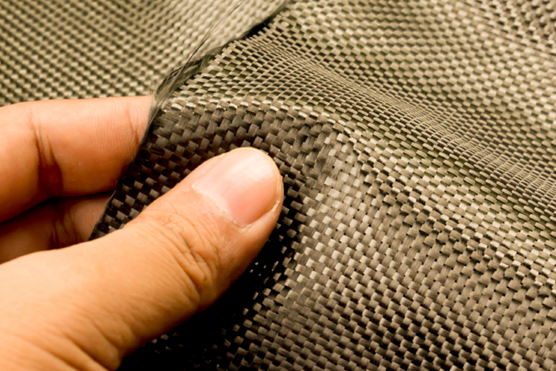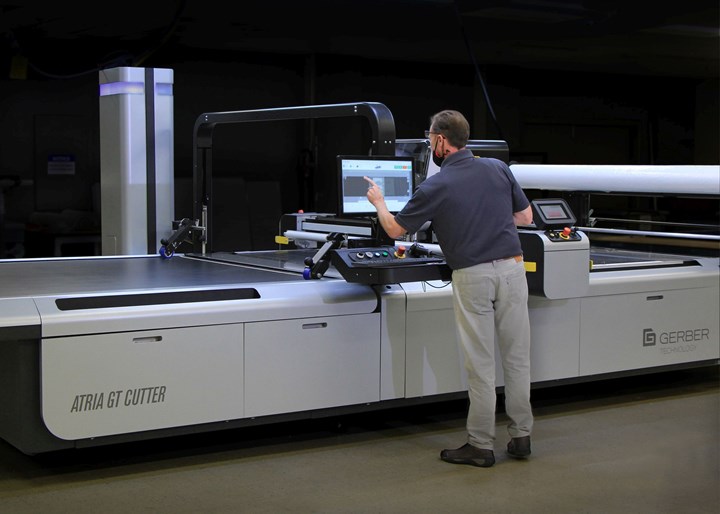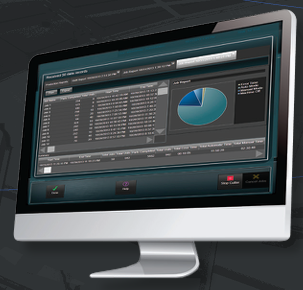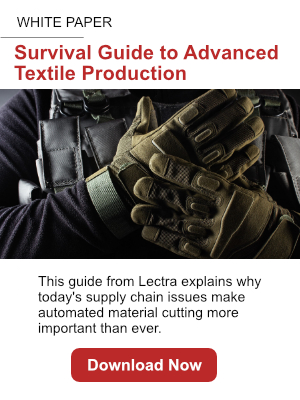Difficult Materials Make Automated Fabric Cutting More Indispensable than Ever
Sponsored ContentWith lingering supply chain shortages, difficult-to-cut materials like Kevlar and many others demand a more accurate and efficient cutting process. Automated cutting is the answer.
Share

Kevlar aramid fabrics can cost over $50 per yard.
If you work with Kevlar, carbon fiber or other high performance reinforcement materials, you know what’s going on in the supply chain. Materials are more expensive and difficult to obtain that ever before. That requires fabricators to cut more accurately, efficiently and predictably than ever before. How well a fabricator manages its materials is key to how well it is able to serve its customers with the ability to consistently meet delivery due dates and at acceptable internal costs.
It's a challenge that Gerber Technology, a Lectra company, has thought about a lot. In a recent whitepaper, Lectra spelled out the argument for automated cutting in today’s supply-challenged environment. Here’s more on their case.
The Need for Automation
The naturally occurring complexity of operations for most any industry hinges on efficient and timely logistics operations to ensure that the right materials are at the right place, at the right time; and that those products are delivered to the customer expeditiously. Staffing shortages have contributed to severe shipping delays for raw materials and products in general, severely impacting manufacturing and production efforts worldwide. Not having the materials needed, rising costs and poor material usage can be disastrous for a fabricator, so it is important to mitigate these effects whenever possible.

Automated cutting systems such as Lectra’s Gerber Atria GT Cutter integrates a variety of features to manage the entire cutting process for a wide variety of fabrics. Its software can define cutting parameters such as tool pressure, vacuum levels and cutting speed on the cutter’s portable workstation and easily adjust them using the touch screen directly at the cutter.
Much is out of a fabricator’s control, but the part that can be managed is the processing and forecasting of materials within an organization. That forces fabricators to take a closer look at their processes in order to improve efficiency and reduce wasted materials. And that’s what has led many to switch from manual to automated cutting processes.
Automation allows a business to focus, not on what is out of their control, but instead on the optimization of what is within their control. They can identify many small things that can improve or speed up their own processes. While one small issue may not make a large dent in profit margins, the accumulation of many small issues being optimized can pay off in dividends.
Saving on Materials
For a fabricator, a huge issue is material savings. When a manual process is employed, it is hard to truly understand how much material is being used for each product, and how to bring consistency to material utilization rates. Without this control, material waste can run as high as 20% or more.

Software is critical to maximizing efficiency and throughput of an automated cutting system. The best systems can automatically nest parts for maximum material utilization and generate machine command programs. Lectra’s Axis software can compile comprehensive reports that analyze system throughput, material yield, processing times, individual job statistics and more.
With automated processes, nesting can be planned and optimized to use the maximum amount of materials and minimize waste in a repeatable way. Furthermore, with precision cutting, the likelihood of errors or “bad” cuts are minimized. Maybe a few yards of scrap material doesn’t seem like it will make a huge difference, but when material is costly small differences add up very quickly. For example, auto-nesting can create material yields up to 90%, saving most customers upwards of 13% of their material per nest. And at $50 per yard or even more you can save almost $200 per day or $1000 per week depending on how many cuts are performed a day.
Keep Molding Processes Up with Fewer People
While we are moving past the time when Covid is so disruptive to fabricator’s work force availability, the shortage of skilled labor has grown more acute by the day. Manual cutting processes require trained hands to do the cuts, roles that new or fill-in people can’t perform efficiently. Machines can repeat cutting processes exactly, and they don’t take days off. Automated processes don’t remove the entire human element from a system, but they do make it easier to continue operations with fewer people which allows the workforce to be dispatched to more value-added tasks. The company can now scale the workforce to better fit its needs.

Machines such as the Gerber MCT Cutter and the GERBERcutter® Z1 IoT-connected models make automation obtainable by manufacturers of all sizes. These types of smart machines can improve efficiency and automate the level of cutting precision. With many being both programmable and adaptable, this allows for a piece of technology that can be used on a variety of projects and with a variety of composite materials. As the project needs change, the technology adapts.
Perhaps an intangible, but none-the-less important is how employees feel about their jobs. By having employees working with the latest technology they can earn better career opportunities in the future. Overall, this helps reduce turnover, and builds a stronger and loyal team. One of the lesser-known benefits for switching to automation is that it can actually help improve the employee experience. Automation tools are often made to do jobs that no one really wants to do, such as standing over a table for hours cutting Kevlar or other hard-to-cut materials.
By transferring these parts of the job to a machine, you are freeing your employees to focus on other critical tasks that may not be ideal for automation. Your employees can also grow with the technology by learning how to use different machines as the equipment line is expanded. This provides them with new skills, stimulation, and growth potential—all while minimizing menial or repetitive tasks and improving the overall quality of work.
Optimizing Margins
While automation can indeed be costly, it is also a huge money-saver. As mentioned earlier, workforce requirements can be lessened, which can yield savings in manpower and salary expenditures. Additionally, automation improves efficiency so that the number of units produced can be increased with the same or less effort, and often expenses too.
Extended uptime, higher quality products with less returns or defects, material savings and resource optimization are all elements of the process that can contribute to a big overall net gain. By looking beyond the immediate expenses of automation, organizations can see the whole picture and identify whether the ability to increase the number of units produced at a same or better price-point will be worth it in the end.
Automation is also a key enabler to growth. Potential customers are less interested in businesses with small operations or lower quality standards. They want companies that can support them through both high and low demand, and automation makes that possible.
With the right technology, resource needs can be identified earlier in the production process and raw materials can be ordered early. This means that an organization may be able to acquire the materials well ahead of their competitors and to pivot quicker to meet changing customer requirements.
Difficult Materials Raise the Bar on Cutting Efficiency
As said at the outset, the stakes go higher as material grows more costly and difficult to process, which brings us back to Kevlar. Kevlar is used for a number of different purposes, but most famously as the material for bullet-proof vests. It is a challenging material to work with, requires special tools to cut, and is expensive. For example, in order to cut Kevlar material, you must use a wheel blade and cut very quickly and cleanly in order to avoid fraying. The problem is that in order to cut the fabric this way, the pattern is likely unused, the cut is not precise and material use is not optimized.
Using an automated process to cut Kevlar and other difficult materials ensures that the cuts are precise and material use is maximized. Gone are the risks of fraying and material loss, and instead are software and cutter machines working in tandem to fully execute the designer’s vision to the highest quality.
For more information please download Lectra’s whitepaper, A 2022 Survival Guide to Advanced Textile Production, or visit Lectra.com.
